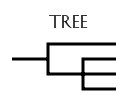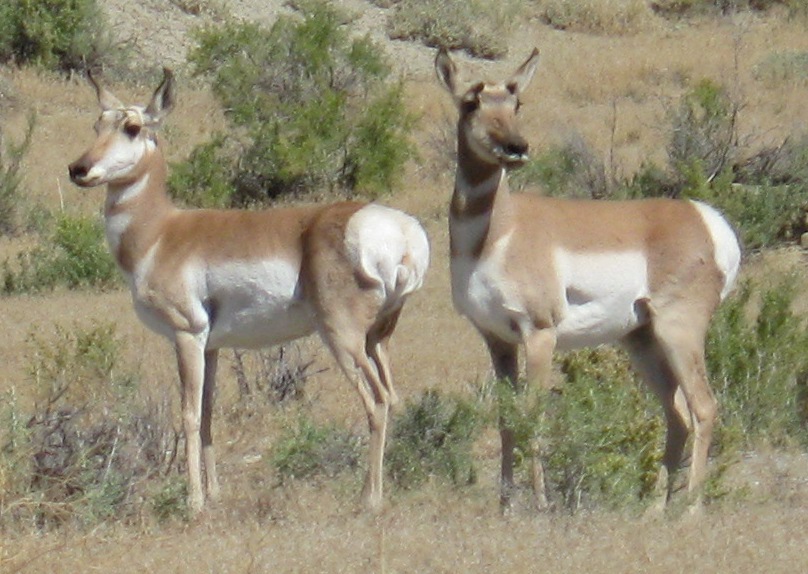| | Female Pronghorns (Antilocapra americana)
Chapter Outline- Description of Mammalia
- Classification of Mammalia
- Prototheria
- Metatheria
- Eutheria
- Afrotheria
- Laurasiatheria
- Artiodactyla
- Carnivora
- Euarchontoglires
- Primates
- Hominidae

NCBI Tree | Paleo Tree
Links to external sites will appear in new windows. | | |
The order Artiodactyla groups together the split-hooved ungulate mammals with the infraorder Cetacea, the whales and dolphins. The ruminants (suborder Ruminantia) is a large enough, and popular enough, group that it will be explored to the subfamily level.
- Xenarthra [38-V]
- Afrotheria [38-VI]
- Boreoeutheria
- Laurasiatheria
- Perissodactyla - Horses, Tapirs, Rhinoceroses [38-VII]
- Insectivora - Hedgehogs, Shrews, Moles [38-VII]
- Pholidota - Pangolins [38-VII]
- Chiroptera - Bats [38-VII]
- Artiodactyla
- Ruminantia - Deer, Bison, Pronghorns, Giraffes, etc.
- Tylopoda - Camels
- Suina - Pigs
- Whippomorpha
- Hippopotamidae - Hippos
- Cetacea - Whales, Dolphins
- Carnivora [38-IX]
- Euarchontoglires [38-X]
The following families are in the suborder Ruminantia: Bovidae (Bison, Cattle, Buffalo, Gazelles, Goats, Sheep), Antilocapridae (Pronghorn), Cervidae (Deer, Elk, Moose), Moschidae (Musk Deer), Giraffidae (Giraffes) and Tragulidae (Chevrotains).
As of 2024, 31 species of Ruminantia have been observed in iNaturalist in the US and 213 throughout the world.
INFRAORDER PECORA
- FAMILY ANTILOCAPRIDAE
- Pronghorn (Antilocapra americana) - Wind River Range, SCZ - NOAH
- FAMILY BOVIDAE
- SUBFAMILY AEPYCEROTINAE
- Impala (Aepyceros melampus rendilis) - SD WAP
- SUBFAMILY ALCELAPHINAE
- Wildebeests (Connochaetes taurinus) - SD WAP
- Bontebok (Damaliscus pygargus) - San Diego Zoo
- SUBFAMILY ANTILOPINAE
- Slender-Horned Gazelle (Gazella leptoceros) - SCZ - 2005 - NOAH
- Speke's Gazelle (Gazella spekei) - St. Louis Zoo - 2022
- Gerenuk (Litocranius walleri) - 6 (St. Louis and Denver Zoos)
- Kirk's Dik Dik (Madoqua kirkii) - 6 (KC Zoo)
- Addra Gazelle (Nanger dama) - St. Louis Zoo - 2022
- Soemmerring's Gazelle (Nanger soemmerringii) - St. Louis Zoo - 2022
- Klipspringer (Oreotragus oreotragus) - 6 (Omaha Zoo), 9 (ABQ Biopark)
- SUBFAMILY BOVINAE
- Bison (Bison bison) - 1 (Yellowstone), 6 (Konza, Tallgrass, SCZ)
- Yak (Bos grunniens) - SCZ - 2018
- Banteng (Bos javanicus) - St. Louis Zoo - 2022
- Cattle (Bos Taurus) - Kansas
- Water Buffalo (Bubalus bubalis) - SCZ - 2018
- African Buffalo (Syncerus caffer) - Denver Zoo - 2023
- Common Eland (Taurotragus oryx) - KC Zoo - 2017
- Nyala (Tragelaphus angasii) - Tulsa Zoo
- Bongo (Tragelaphus eurycerus) - KC Zoo - 2022
- Lesser Kudo (Tragelaphus imberbis) - 6 (St. Louis and Denver Zoos) - 2023
- SUBFAMILY CAPRINAE
- Takin (Budorcas taxicolor) - St. Louis Zoo - 2022
- Pygmy Goat (Capra hircus) - 6 (Omaha Zoo)
- Chinese Goral (Naemorhedus griseus) - St. Louis Zoo - 2022
- Mountain Goat (Oreamnos americanus) - Rocky Mountain NP - 1998 - NOAH
- Muskox (Ovibos moschatus) - ANWR
- Sheep (Ovis aries) - 6 (KC Zoo)
- Bighorn Sheep (Ovis canadensis) - 1 (Wind River Range, Yellowstone), 6 (RMNP), Wild Rivers, NM
- Transcaspian Urial (Ovis vignei arkal) - St. Louis Zoo - 2022
- SUBFAMILY CEPHALOPHINAE
- Blue Duiker (Cephalophus monticola bicolor) - KC Zoo - 2022 - NOAH
- Red-Flanked Duiker (Cephalophus rufilatus) - KC Zoo - 2005 - NOAH
- Yellow-Backed Duiker (Cephalophus silvilcultor) - 6 (Omaha & KC Zoos) - 2017 - NOAH
- SUBFAMILY HIPPOTRAGINAE
- Addax (Addax nasomaculatus) - 6 (KC & St. Louis Zoos) - 2022
- Scimtar-Horned Oryx (Oryx dammah) - KC Zoo - 2022
- Gemsbok (Oryx gazella) - White Sands
- SUBFAMILY PELEINAE
- Grey Rhebok (Pelea capreolus) - San Diego Zoo
- SUBFAMILY REDUNCINAE
- Nile Lechwe (Kobus megaceros) - St. Louis Zoo - 2022
- FAMILY CERVIDAE
- SUBFAMILY CERVINAE
- Elk/Wapiti/Red Deer (Cervus elaphus) - 1 (Yellowstone), 6 (RMNP) - NOAH
- Fallow Deer (Dama dama) - (Exotic in Texas)
- Burmese Brow-Antlered Deer (Rucervus eldii thamin) - SCZ - 2018
- SUBFAMILY HYDROPOTINAE
- Chinese Water Deer (Hydropotes inermis) - Wildlife World Zoo, AZ
- SUBFAMILY MUNTIACINAE
- Tufted Deer (Elaphodus cephalophus) - Omaha & KC Zoos - 2006
- Indian Muntjac (Muntiacus muntjak) - SCZ - 2005
- Chinese Muntjac (Muntiacus reevesi) - Tulsa Zoo
- SUBFAMILY ODOCOILEINAE
- Moose (Alces alces) - Yellowstone, RMNP
- Mule Deer (Odocoileus hemionus) - Wind River Range, Yellowstone, RMNP
- White-Tailed Deer (Odocoileus virginianus)
- Greenwood County, Kansas (fawn) - 10/28/2004 - NOAH
- Devonian Gorge (juveniles) - 8/8/2005 - NOAH
- Adirondacks, Konza
- Key Deer (Odocoileus virginianus clavius) - Florida Keys
- Caribou (Rangifer tarandus) - ANWR, Topeka Zoo (temporary)
- Pudu (Pudu puda) - SCZ - 2018
- FAMILY GIRAFFIDAE
- Giraffe (Giraffa camelopardalis) - SCZ - 2021
- Okapi (Okapia johnstoni) - 6 (SCZ, Denver & Omaha Zoos)
- FAMILY MOSCHIDAE
- Musk Deer (Moschus moschiferus) - San Diego Zoo
INFRAORDER TRAGULINA
- FAMILY TRAGULIDAE
- Chevrotain (Tragulus napu) - Topeka Zoo - 2022 - NOAH
Camelidae is the only family in the suborder Tylopoda and includes camels and llamas. As of 2024, 0 species of Tylopoda have been observed in iNaturalist in the US and 7 throughout the world.
- Bactrian (2 hump) Camel (Camelus bactrianus) - St. Louis Zoo - 2022
- Dromedary (1 hump) Camel (Camelus dromedarius) - SCZ & KC Zoos - 2022
- Llama (Lama glama)
- Guanaco (Lama guanicoe) - SCZ - 2005
The suborder of Pigs and Peccaries. As of 2024, 2 species of Suina have been observed in iNaturalist in the US and 18 throughout the world.
- FAMILY SUIDAE
- Babirusa (Babyrousa celebensis) - St. Louis Zoo
- Warthog (Phacochoerus africanus) - 6 (SCZ & KC Zoos), 9 (ABQ Biopark) - NOAH
- Southern Warthog (Phacochoerus africanus sundevallii) - ABQ Biopark
- Red River Hog (Potamochoerus porcus) - SCZ & KC Zoos - NOAH
- Bornean Bearded Pig (Sus barbatus) - Omaha Zoo - 2006 - NOAH
- Wild Boar (Sus scrofa) - most iNat observations in the US for Suina. Introduced.
- FAMILY TAYASSUIDAE
- Peccary/Javelina (Pecari tajacu) - only native iNat species in the US for Suina
- Big Bend - 1995
- SCZ & Omaha Zoos - 2021
This section and the next explore mammals in the suborder Whippomorpha. Whippomorpha contains two infraorders, Ancodonta and Cetacea. Hippopotamidae is the only family in the infraorder Ancodonta and contains the hippos. It is the only family in Whippomorpha that contains species that live both in water and on land. The other infraorder, Ceatacea, contains the whales and dolphins, and they are in the next section below. Hippos are the land mammals most closely-related to the Cetaceans.
As of 2024, 0 species of Hippopotamidae have been observed in iNaturalist in the US and just 2 throughout the world.
- Pygmy Hippopotamus (Hexaprotodon liberiensis) - Omaha Zoo (Lied Jungle) - 2017 -
NOAH
- Common Hippopotamus (Hippopotamus amphibius) - SCZ & KC Zoos - 2022 -
NOAH
Cetacea is the infraorder of whales and dolphins within the suborder Whippomorpha. Though exclusively aquatic, they are closely related to the hippos and the split-hooved ungulates listed on this page.
As of 2024, 44 species of Cetacea have been observed in iNaturalist in the US and 91 throughout the world.
The best time to experience whales in Monterey Bay is from late Summer to Fall.
SUBORDER MYSTICETI
- FAMILY BALAENIDAE
- Right Whale (Eubalaena glacialis) - Gulf of Maine
- Bowhead Whale (Balaena mysticetus) - Bering LB
- FAMILY BALAENOPTERIDAE
- Minke Whale (Balaenoptera acutorostrata) - Monterey Bay, Gulf of Maine, Glacier Bay, Bering LB
- Sei Whale (Balaenoptera borealis) - Monterey Bay, Gulf of Maine, Glacier Bay
- Blue Whale (Balaenoptera musculus) - Monterey Bay, Gulf of Maine, Glacier Bay
- Finback Whale (Balaenoptera physalus) - Monterey Bay, Gulf of Maine, Glacier Bay, Bering LB
- Humpback Whale (Megaptera novaeangliae) - Monterey Bay, Gulf of Maine, Glacier Bay, Hawaii
- FAMILY ESCHRICHTIIDAE
- Grey Whale (Eschrichtius robustus) - Monterey Bay, Gulf of Maine, Glacier Bay, Bering LB
- FAMILY NEOBALAENIDAE
- Pygmy Right Whale (Caperea marginata) - Southern Hemisphere
SUBORDER ODONTOCETI
- FAMILY DELPHINIDAE
- Common Dolphin (Delphinus delphis) - Monterey Bay, Gulf of Maine
- Pilot Whales (Globicephala) - Monterey Bay, Gulf of Maine
- Grampus/Risso’s Dolphin (Grampus griseus) - Monterey Bay, Gulf of Maine
- Pacific White-Sided Dolphin (Lagenorhynchus obliquidens) - 7 (Monterey Bay), 8 (Shedd), 11 (Glacier Bay)
- Northern Right-Whale Dolphin (Lissodelphis borealis) - Monterey Bay
- Orca (Orcinus orca) - Monterey Bay, Gulf of Maine, Mid-Atlantic, Glacier Bay, Bering LB
- Spinner, Spotted & Striped Dolphins (Stenella) - Monterey Bay, Gulf of Maine, Mid-Atlantic
- Bottlenose Dolphin (Tursiops truncatus) - Florida Keys, Monterey Bay
- FAMILY INIIDAE
- FAMILY LIPOTIDAE
- Yangtze River Dolphin (Lipotes vexillifer) -
- FAMILY MONODONTIDAE
- Beluga Whale (Delphinapterus leucas) - Bering LB, Gulf of Maine, Shedd & Georgia Aquariums
- Narwhal (Monodon monoceros) - Bering LB
- FAMILY PHOCOENIDAE
- Harbor Porpoise (Phocoena phocoena) - Monterey Bay, Gulf of Maine, Mid-Atlantic, Glacier Bay, Bering LB
- Dall's Porpoise (Phocoena dalli) - Monterey Bay, Glacier Bay
- FAMILY PHYSETERIDAE
- Pygmy Sperm Whale (Kogia breviceps) - Monterey Bay, Gulf of Maine, Mid-Atlantic, Glacier Bay
- Dwarf Sperm Whale (Kogia sima) - Monterey Bay, Gulf of Maine, Mid-Atlantic
- Sperm Whale (Physeter catodon) - Monterey Bay, Gulf of Maine, Mid-Atlantic, Glacier Bay
- FAMILY PLATANISTIDAE
- Freshwater Dolphins (Platanista spp.) - (India)
- FAMILY PONTOPORIIDAE
- Franciscana (Pontoporia blainvillei) -
- FAMILY ZIPHIIDAE
- Baird's Beaked Whale (Berardius bairdii) - Monterey Bay, Glacier Bay
- Bottlehead (Hyperoodon ampullatus) - Gulf of Maine, Mid-Atlantic
- Beaked Whales (Mesoplodon) - Monterey Bay, Gulf of Maine, Mid-Atlantic, Glacier Bay
- Cuvier’s Beaked Whale (Ziphius cavirostris) - Monterey Bay, Gulf of Maine, Mid-Atlantic
| |

